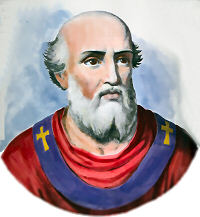» Enjoy our Liturgical Seasons series of e-books!
John I was elected Pope in 523. The Arian King Theodoric sent him as his ambassador to Emperor Justin in Constantinople. On his return, he was captured by the king, who was displeased at the outcome of the embassy, and cast into prison at Ravenna where he died a few days later. As pope he was responsible for introducing the Alexandrian computation of the date of Easter; it came to be accepted throughout the west.
Before the reform of the General Roman Calendar St. John I's feast was celebrated on May 27. Today was the feast of St. Venantius, whose feast is no longer celebrated in the United States, but he remains on the Universal Calendar. He was born at Camerino in Umbria, and was led at the age of fifteen before Antiochus, governor of the town under the Emperor Decius. He was made to suffer cruel torments, but angels came and assisted him. His tormentors were touched with repentance by his constancy and many were converted. He was beheaded around the year 250. His body lies at Camerino in the church dedicated to him.
St. John I
This Tuscan was destined to be glorified not only during his lifetime but after his death as well. Although peace with the East had been restored, a suspicious Theodoric grumbled in his castle at Ravenna. An Arian, the king saw the new friendliness between East and West as a serious threat to his reign. To further alarm him, Emperor Justin had reinstated the laws against heretics, Arians included, and had embarked on a campaign of confiscating churches and excluding heretics from public office, causing many Arians to abandon their faith. Infuriated, Theodoric summoned John to Ravenna and ordered him to head a delegation to the orthodox emperor to ask that the persecution stop and allow forced converts to return to Arianism. At first John refused, then fearing that the king's wrath would be taken out on Western Catholics, he agreed to do Theodoric's bidding on every count save one. He boldly told the king that he would not ask the emperor to allow converts to return to heresy.
The pope arrived in Constantinople shortly before Easter in 526, and since he was the first pope to leave Italy, his reception was more than he could have dreamed. He had been met by the entire city at the twelfth milestone, where the clergy led the procession carrying candles and crosses, and even the emperor prostrated himself before the Holy Father.  The day of Easter, John was seated in a throne higher than the one occupied by the patriarch, in the church of Sancta Sophia, where he celebrated Mass in the Latin tradition. John was accorded the highest honor when he placed the customary Easter crown on the head of Emperor Justin.
The day of Easter, John was seated in a throne higher than the one occupied by the patriarch, in the church of Sancta Sophia, where he celebrated Mass in the Latin tradition. John was accorded the highest honor when he placed the customary Easter crown on the head of Emperor Justin.
After meeting with Justin on Theodoric's behalf, the pope made the exhausting trip back to Ravenna. The king's fury raged. Jealous of the pope's grand reception in the East, Theodoric accused the pope of failing his mission by not securing all of the demands put to Justin. The king then ordered John to remain in Ravenna at his disposal. The aged pope was spent; the prospects before him were dismal. Already ailing, Pope John died and was hastily buried outside the castle walls. Pope John's body was exhumed and on May 27, 526, was returned to Rome and placed in the nave of St. Peter's.
—Excerpted from The Popes: A Papal History, J.V. Bartlett
Highlights and Things to Do:
- The Church has had a long, unbroken line of popes. Have your children answer the following questions: How many popes has the Church had? How many popes are honored with the title of saint, blessed or venerable? Which pope reigned longest? Which three names have been chosen most frequently by popes? You can check this page to help get the answers.
- Pray especially for the Holy Father today. Pray a type of the Morning Offering in which we pray for the Holy Father's intentions.
- Read more about Pope St. John I:
- Pope John is buried in St. Peter's Basilica.







